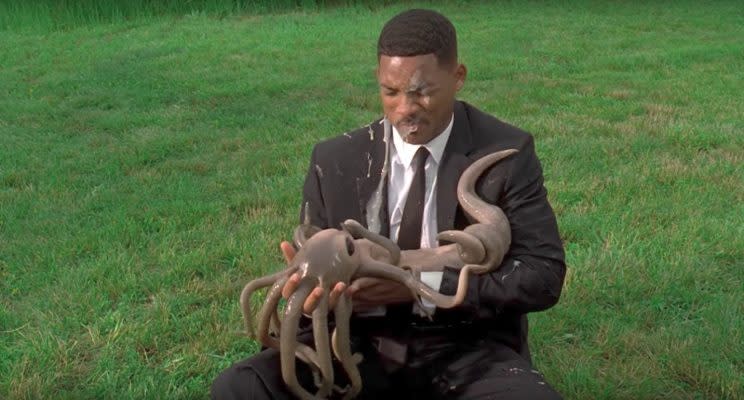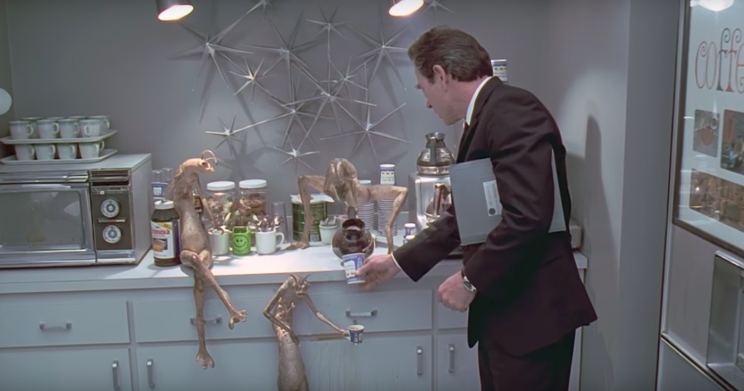'Men in Black' Turns 20: How It Rewrote the Playbook for Movie Special Effects

On July 2, 1997, the sci-fi comedy Men in Black opened in theaters, introducing audiences to the extraterrestrials who secretly live on Earth and the straight-faced special agents (played by Will Smith and Tommy Lee Jones) charged with keeping them in line. While Smith, at the height of his film stardom, was the biggest audience draw, what really made the film click was the aliens: a delightful rogue’s gallery of weird creatures living amongst and inside ordinary humans. Twenty years later, Hollywood is experiencing a nostalgia for “practical effects,” the art of creating effects in-camera with puppets and makeup — which is how effects artist Rick Baker designed the alien population of Men in Black. But the film also used computer graphics to supplement, and sometimes replace, Baker’s tactile creations. To watch Men in Black now is to see Hollywood’s transition from practical effects to CG… and to understand why filmmakers are circling back.
Baker, who won one of his seven Oscars for Men in Black, has described the film in multiple interviews as “design hell.” By that, he doesn’t mean that working on it was a total nightmare — after all, he returned for two sequels — but that his creative process was continually stalled while he waited for director Barry Sonnenfeld and executive producer Steven Spielberg to hash out exactly what they wanted. “There were so many people involved in the designs and nothing was getting approved and time was a-wasting,” Baker said in a 2015 video interview. Sometimes, this meant that designs he spent months building were suddenly scrapped, like the insectoid alien from the film’s climactic battle, which was replaced with a CG creature. (Take a look at Baker’s giant puppet version here.) But other puppets make it onto the screen with memorable results, like Rosenberg, the dying alien hidden behind a human face. Watch the scene:
That alien, nicknamed “Chucky” by Baker, was performed by two different-sized puppets, the larger of which had articulated lips and blinking eyes. The dialogue was synced digitally with the puppet by a computer program, as shown in the video below.
A minimum of computer animation was used on that alien, while only slightly more was used for the “worm” aliens, ultimately one of the franchise’s most popular creatures, who began their lives as simple rod puppets in Baker’s studio.

Other characters were a more equal blend of practical and digital effects. Take “Mikey,” the first alien to be unmasked in the film. As shown in the clip below, Baker spent 10 months creating an 8-foot-tall alien suit to be worn by a real actor, with a head and body parts controlled by 10 remote operators. Even so, the design team couldn’t figure out a way for the creature to run quickly, as required by the script. So the practical Mikey is replaced by a CG Mikey partway through his brief scene.
For most of Hollywood history, special effects didn’t work like this. If a director needed a cast of aliens, those aliens had to be designed, created, and made camera-ready in the months leading up to the shoot. By the time filming wrapped, the creature designer’s job was done, and the aliens on camera were the ones who made the final cut. If the director wasn’t happy with how it looked, his only option was to reshoot it — much like George Lucas shot extra footage for the Star Wars cantina scene, including new aliens designed by Baker.
In contrast, digital effects enable the designers to do much of their work in post-production, inserting characters and design elements into scenes after they’ve been shot. On Men in Black, the studio tried it both ways: they hired a massive crew of makeup and creature artists to make aliens in the months leading up to the shoot, and then employed Industrial Light and Magic’s team of digital artists to create the remaining aliens, and add realistic touches to the existing puppets, in post-production.
That giant preproduction period, once standard on sci-fi and fantasy films, is incredibly lavish by today’s standards. It’s much more efficient and affordable to create a majority of the effects digitally, after the cameras have stopped rolling. Men in Black was made just at the cusp of Hollywood’s full transition to digital, which was heralded by previous ILM films Terminator 2: Judgment Day and Forrest Gump. With the next few years, The Phantom Menace and The Lord of the Rings: The Fellowship of the Ring would serve as bold announcements that practical effects were a thing of the past.
Except, they weren’t — not really. Baker designed aliens for both Men in Black sequels and continued to work in Hollywood, often in collaboration with digital artists, until his 2015 retirement. That year, he lamented the loss of the “big jobs” that “don’t exist anymore,” but acknowledged that the industry had been changing for some time. Coincidentally, 2015 was also the year that Star Wars: The Force Awakens opened in theaters — a film that used the promise of “practical effects” very heavily in its promotion. Audiences who felt that the original Star Wars films looked better than the prequels (whose ambitious, early CG has objectively not aged well) were thrilled at the return of animatronic droids and actors in alien masks.
That said, the approach taken by director J.J. Abrams on The Force Awakens is much closer to Men in Black than it is to The Empire Strikes Back. Abrams’ practical creatures and effects were heavily supplemented with digital in post-production. And that’s the case with all of the recent blockbusters that used practical effects as a selling point, including Mad Max: Fury Road and Spider-Man: Homecoming. There’s no going back to the old way, when characters and effects looked basically the same on-set as they did on screen. However, filmmakers are now recognizing that there’s value in the old-school approach, when actors could really interact with a film’s fantasy elements. That’s why director Bill Condon insisted on having actual props built of the talking clock, candlestick, and teapot in his live-action Beauty and the Beast, and why puppeteers were hired to help create realistic animals in The Revenant. In Baker’s words, “I think there’s a real difference when you know that something’s really happening.”
Just look at that tiny, dying alien from Men in Black; in a matter of seconds, the puppet’s performance tells the story of a whole life. That’s the kind of effect that any director strives for, and whether it’s achieved with digital rendering or foam latex doesn’t matter in the end.
Rick Baker at Work: Watch the ‘Building a Better Alien’ Featurette From ‘Men In Black 3’:
Read more from Yahoo Movies:

